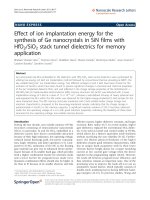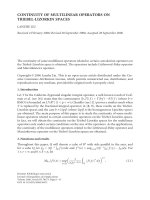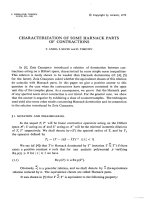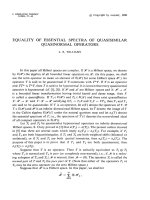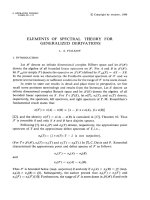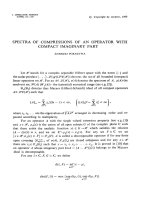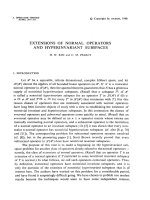Báo cáo toán học: "Boundedness of Multilinear Littlewood-Paley Operators for the Extreme Cases" potx
Bạn đang xem bản rút gọn của tài liệu. Xem và tải ngay bản đầy đủ của tài liệu tại đây (146.3 KB, 12 trang )
Vietnam Journal of Mathematics 33:2 (2005) 123–134
Boundedness of Multilinear Littlewood-Paley
Operators for the Extreme Cases
*
Liu Lanzhe
College of Mathematics, Changsha University of Science and Technology
Changsha 410077, China
Received July 7, 2003
Revised Decem ber 4, 2004
Abstract. The purpose of this paper is to study the boundedness prop erties of
multilinear Littlewood-Paley operators f or the extreme cases.
1. Introduction and Results
Fix δ>0. Let ψ be a fixed function which satisfies the following properties:
(1)
R
n
ψ(x)dx =0,
(2) |ψ(x)|≤C(1 + |x|)
−(n+1−δ)
,
(3) |ψ(x + y) − ψ(x)|≤C|y|(1 + |x|)
−(n+2−δ)
when 2|y| < |x|.
We denote Γ(x)={(y, t) ∈ R
n+1
+
: |x − y| <t} and the characteristic
function of Γ(x)byχ
Γ(x)
.Letm be a positive integer and A be a function on
R
n
. The multilinear Littlewood-Paley operator is defined by
S
A
δ
(f)(x)=
Γ(x)
|F
A
t
(f)(x, y)|
2
dydt
t
n+1
1/2
,
where
∗
This work was supported by the NNSF (Grant: 10271071).
124 Liu Lanzhe
F
A
t
(f)(x, y)=
R
n
R
m+1
(A; x, z)
|x − z|
m
f(z)ψ
t
(y −z)dz,
R
m+1
(A; x, y)=A(x) −
|α|≤m
1
α!
D
α
A(y)(x − y)
α
and ψ
t
(x)=t
−n+δ
ψ(x/t)fort>0. Set F
t
(f)(y)=f ∗ ψ
t
(y). We also define
S
δ
(f)(x)=
Γ(x)
|F
t
(f)(y)|
2
dydt
t
n+1
1/2
,
which is the Littlewood-Paley operator (see [14]).
Let H be the Hilbert space H =
h : h =
R
n+1
+
|h(t)|
2
dydt/t
n+1
1/2
<
∞
. Then for each fixed x ∈ R
n
, F
A
t
(f)(x, y) may be viewed as a mapping
from (0, +∞)toH, and it is clear that
S
A
δ
(f)(x)=
χ
Γ(x)
F
A
t
(f)(x, y)
,S
δ
(f)(x)=
χ
Γ(x)
F
t
(f)(y)
.
We also consider the variant of S
A
δ
, which is defined by
˜
S
A
δ
(f)(x)=
Γ(x)
|
˜
F
A
t
(f)(x)|
2
dt
t
n+1
1/2
,
where
˜
F
A
t
(f)(x)=
R
n
Q
m+1
(A; x, y)
|x − y|
m
ψ
t
(x − y)f(y)dy
and
Q
m+1
(A; x, y)=R
m
(A; x, y) −
|α|=m
1
α!
D
α
A(x)(x − y)
α
.
Note that when m =0,S
A
δ
is just the commutator of Littlewood-Paley
operator (see [1, 11, 12]). It is well known that multilinear operators, as the
extension of Commutators, are of great interest in harmonic analysis and have
been widely studied by many authors (see [3 - 6, 8]). In [2, 7], the L
p
(p>1)
boundedness of commutators generated by the Calder´on-Zygmund operator or
fractional integral operator and BMO functions are obtained, and in [11], the
endpoint boundedness of commutators generated by the Calder´on-Zygmund
operator and BMO functions are obtained. The main purpose of this paper
is to discuss the boundedness properties of the multilinear Littlewood-Paley
operators for the extreme cases of p. Throughout this paper, the letter C
s will
denote the positive constants which may have different values in each line; B
will denote a ball of R
n
. ForaballB,setf
B
= |B|
−1
B
f(x)dx and f
#
(x)=
sup
x∈B
|B|
−1
B
|f(y) −f
B
|dy.
Boundedness of Multilinear Littlewood-Paley Operators for the Extreme Cases 125
We shall prove the following theorems in Sec. 3.
Theorem 1. Let 0 ≤ δ<nand D
α
A ∈ BMO(R
n
) for |α| = m.ThenS
A
δ
is
bounded from L
n/δ
(R
n
) to BMO(R
n
).
Theorem 2. Let 0 ≤ δ<nand D
α
A ∈ BMO(R
n
) for |α| = m.Then
˜
S
A
δ
is
bounded from H
1
(R
n
) to L
n/(n−δ)
(R
n
).
Theorem 3. Let 0 ≤ δ<nand D
α
A ∈ BMO(R
n
) for |α| = m.ThenS
A
δ
is
bounded from H
1
(R
n
) to weak L
n/(n−δ)
(R
n
).
Theorem 4. Let 0 ≤ δ<nand D
α
A ∈ BMO(R
n
) for |α| = m.
(i) If for any H
1
-atom a supported on certain cube Q and u ∈ 3Q \2Q,there
is
(4Q)
c
χ
Γ(x)
|α|=m
1
α!
(x − u)
α
|x − u|
m
ψ
t
(y −u)
Q
D
α
A(z)a(z)dz
n/(n−δ)
dx ≤ C,
then S
A
δ
is bounded from H
1
(R
n
) to L
n/(n−δ)
(R
n
);
(ii) If for any cube Q and u ∈ 3Q \ 2Q,thereis
1
|Q|
Q
χ
Γ(x)
|α|=m
1
α!
(D
α
A(x) − (D
α
A)
Q
)
(4Q)
c
(u − z)
α
|u − z|
m
ψ
t
(u − z)f(z)dz
dx ≤ C||f||
L
n/δ
,
then
˜
S
A
δ
is bounded from L
n/δ
(R
n
) to BMO(R
n
).
2. Proofs of Theorems
We begin with some preliminary lemmas.
Lemma 1. (see [6]) Let A be a function on R
n
and D
α
A ∈ L
q
(R
n
) for |α| = m
and some q>n.Then
|R
m
(A; x, y)|≤C|x −y|
m
|α|=m
1
|
˜
B(x, y)|
˜
B(x,y)
|D
α
A(z)|
q
dz
1/q
,
where
˜
B(x, y) is the ball centered at x and having radius 5
√
n|x − y|.
Lemma 2. Let 0 ≤ δ<n, 1 <p<n/δand D
α
A ∈ BMO(R
n
) for |α| = m,
1 <r≤∞, 1/q =1/p +1/r − δ/n.ThenS
A
δ
is bounded from L
p
(R
n
) to
L
q
(R
n
), that is
126 Liu Lanzhe
||S
A
δ
(f)||
L
q
≤ C
|α|=m
||D
α
A||
BMO
||f||
L
p
.
Proof. By Minkowski inequality and by the condition of ψ,wehave
S
A
δ
(f)(x) ≤
R
n
|f(z)||R
m+1
(A; x, z)|
|x − z|
m
Γ(x)
|ψ
t
(y −z)|
2
dydt
t
1+n
1/2
dz
≤ C
R
n
|f(z)||R
m+1
(A; x, z)|
|x − z|
m
∞
0
|x−y|≤t
t
−2n+2δ
(1 + |y −z|/t)
2n+2−2δ
dydt
t
1+n
1/2
dz
≤ C
R
n
|f(z)||R
m+1
(A; x, z)|
|x − z|
m
∞
0
|x−y|≤t
2
2n+2−2δ
· t
1−n
(2t + |y −z|)
2n+2−2δ
dydt
1/2
dz.
Noting that 2t + |y −z|≥2t + |x − z|−|x − y|≥t + |x − z| when |x − y|≤t
and
∞
0
tdt
(t + |x −z|)
2n+2−2δ
= C|x −z|
−2n+2δ
,
we obtain
S
A
δ
(f)(x) ≤ C
R
n
|f(z)||R
m+1
(A; x, z)|
|x − z|
m
⎛
⎝
∞
0
tdt
(t + |x − z|)
2n+2−2δ
⎞
⎠
1/2
dz
= C
R
n
|f(z)||R
m+1
(A; x, z)|
|x − z|
m+n−δ
dz.
Thus, the lemma follows from [8].
Proof of Theorem 1. It suffices to prove that there exists a constant C depending
on B such that
1
|B|
B
|S
A
δ
(f)(x) − C
B
|dx ≤ C
B
||f||
L
n/δ
holds for any ball B.FixaballB = B(x
0
,l). Let
˜
B =5
√
nB and
˜
A(x)=
A(x)−
|α|=m
1
α!
(D
α
A)
˜
B
x
α
,thenR
m
(A; x, y)=R
m
(
˜
A; x, y)andD
α
˜
A = D
α
A−
(D
α
A)
˜
B
for |α| = m.Wewrite,forf
1
= fχ
˜
B
and f
2
= fχ
R
n
\
˜
B
, F
A
t
(f)(x)=
F
A
t
(f
1
)(x)+F
A
t
(f
2
)(x), then
Boundedness of Multilinear Littlewood-Paley Operators for the Extreme Cases 127
1
|B|
B
|S
A
δ
(f)(x) − S
A
δ
(f
2
)(x
0
)|dx
=
1
|B|
B
||χ
Γ(x)
F
A
t
(f)(x, y)|| −||χ
Γ(x)
F
A
t
(f
2
)(x
0
,y)||
dx
≤
1
|B|
B
S
A
δ
(f
1
)(x)dx +
1
|B|
B
||χ
Γ(x)
F
A
t
(f
2
)(x, y) − χ
Γ(x)
F
A
t
(f
2
)(x
0
,y)||dx
:= I + II.
Now, let us estimate I and II . First, taking p>1andq>1 such that
1/q =1/p − δ/n,bythe(L
p
,L
q
) boundedness of S
A
δ
(Lemma 2), we gain
I ≤
1
|B|
B
(S
A
δ
(f
1
)(x))
q
dx
1/q
≤ C|B|
−1/q
||f
1
||
L
p
= C||f ||
L
n/δ
.
To estimate II,wewrite
χ
Γ(x)
F
A
t
(f
2
)(x, y) − χ
Γ(x)
F
A
t
(f
2
)(x
0
,y)
=
1
|x − z|
m
−
1
|x
0
− z|
m
χ
Γ(x)
ψ
t
(y −z)R
m
(A; x, z)f
2
(z)dz
+
χ
Γ(x)
ψ
t
(y −z)f
2
(z)
|x
0
− z|
m
[R
m
(A; x, z) − R
m
(A; x
0
,z)]dz
+
(χ
Γ(x)
− χ
Γ(x
0
)
)
ψ
t
(y −z)R
m
(A; x
0
,z)f
2
(z)
|x
0
− z|
m
dz
−
|α|=m
1
α!
χ
Γ(x)
(x − z)
α
|x − z|
m
−
χ
Γ(x
0
)
(x
0
− z)
α
|x
0
− z|
m
ψ
t
(y −z)D
α
˜
A(z)f
2
(z)dz
:= II
t
1
(x)+II
t
2
(x)+II
t
3
(x)+II
t
4
(x).
We cho ose r>1 such that 1/r + δ/n =1. Notethat|x−z|∼|x
0
−z| for x ∈
˜
B
and z ∈ R
n
\
˜
B, similar to the proof of Lemmas 2 and 1, we have
1
|B|
B
||II
t
1
(x)||dx
≤
C
|B|
B
R
n
\
˜
B
|x − x
0
||f(z)|
|x − z|
n+m+1−δ
|R
m
(
˜
A; x, z)|dz
dx
≤
C
|B|
B
∞
k=0
2
k+1
˜
B\2
k
˜
B
|x − x
0
||f(z)|
|x − z|
n+m+1−δ
|R
m
(
˜
A; x, z)|dz
dx
128 Liu Lanzhe
≤ C
∞
k=0
l(2
k
l)
m
(2
k
l)
n+m+1−δ
k
|α|=m
||D
α
A||
BMO
2
k
˜
B
|f(z)|dz
≤ C
|α|=m
||D
α
A||
BMO
||f||
L
n/δ
∞
k=0
k2
−k
≤ C
|α|=m
||D
α
A||
BMO
||f||
L
n/δ
.
For II
t
2
(x), by the formula (see [6])
R
m
(
˜
A; x, z) − R
m
(
˜
A; x
0
,z)
= R
m
(
˜
A; x, x
0
)+
0<|β|<m
1
β!
R
m−|β|
(D
β
˜
A; x
0
,z)(x − x
0
)
β
and by Lemma 1, we get
|R
m
(
˜
A; x, z) − R
m
(
˜
A; x
0
,z)|
≤ C
|α|=m
||D
α
A||
BMO
(|x − x
0
|
m
+
0<|β|<m
|x
0
− z|
m−|β|
|x − x
0
|
|β|
),
thus, for x ∈ B,
||II
t
2
(x)|| ≤ C
R
n
|f
2
(z)|
|x − z|
m+n−δ
|R
m
(
˜
A; x, z) − R
m
(
˜
A; x
0
,z)|dz
≤ C
|α|=m
||D
α
A||
BMO
R
n
|x − x
0
|
m
+
0<|β|<m
|x
0
− z|
m−|β|
|x − x
0
|
|β|
|x
0
− z|
m+n−δ
|f
2
(z)|dz
≤ C
|α|=m
||D
α
A||
BMO
∞
k=0
kl
m
(2
k
l)
m+n−δ
2
k
˜
B
|f(z)|dz
≤ C
|α|=m
||D
α
A||
BMO
||f||
L
n/δ
∞
k=1
k2
−km
≤ C
|α|=m
||D
α
A||
BMO
||f||
L
n/δ
.
For II
t
3
(x), note that |x + y − z|∼|x
0
+ y − z| for x ∈
˜
B and z ∈ R
n
\
˜
B,we
obtain, similar to the estimate of II
1
,
Boundedness of Multilinear Littlewood-Paley Operators for the Extreme Cases 129
||II
t
3
(x)||
≤ C
R
n
R
n+1
+
|ψ
t
(y −z)||f
2
(z)||R
m
(
˜
A; x
0
,z)|
|x
0
− z|
m
×|χ
Γ(x)
(y,t) − χ
Γ(x
0
)
(y,t)|
2
dydt
t
n+1
1/2
dz
≤ C
R
n
|f
2
(z)|R
m
(
˜
A; x
0
,z)|
|x
0
− z|
m
×
Γ(x)
t
1−n
dydt
(t + |y −z|)
2n+2−2δ
−
Γ(x
0
)
t
1−n
dydt
(t + |y −z|)
2n+2−2δ
1/2
dz
≤ C
R
n
|f
2
(z)|R
m
(
˜
A; x
0
,z)|
|x
0
− z|
m
×
|y|≤t
1
(t + |x + y −z|)
2n+2−2δ
−
1
(t + |x
0
+ y − z|)
2n+2−2δ
dydt
t
n−1
1/2
dz
≤ C
R
n
|f
2
(z)|R
m
(
˜
A; x
0
,z)|
|x
0
− z|
m
×
|y|≤t
|x − x
0
|t
1−n
dydt
(t + |x + y −z|)
2n+3−2δ
1/2
dz
≤ C
R
n
|f
2
(z)||x − x
0
|
1/2
|R
m
(
˜
A; x
0
,z)|
|x
0
− z|
m+n+1/2−δ
dz
≤ C
∞
k=0
kl
1/2
(2
k
l)
m
(2
k
l)
n+m+1/2−δ
||f||
L
n/δ
|α|=m
||D
α
A||
BMO
≤ C
|α|=m
||D
α
A||
BMO
||f||
L
n/δ
∞
k=0
k2
−k/2
≤ C
|α|=m
||D
α
A||
BMO
||f||
L
n/δ
.
For II
t
4
(x), similar to the estimate of II
t
3
(x), we have
II
t
4
(x)≤C
R
n
\
˜
B
|x − x
0
|
|x − z|
n+1−δ
+
|x − x
0
|
1/2
|x − z|
n+1/2−δ
|α|=m
|D
α
˜
A(z)||f(z)|dz
≤ C
|α|=m
||D
α
A||
BMO
||f||
L
n/δ
∞
k=0
k(2
−k
+2
−k/2
)
≤ C
|α|=m
||D
α
A||
BMO
||f||
L
n/δ
.
Combining these estimates, we complete the proof of Theorem 1.
130 Liu Lanzhe
Proof of Theorem 2. It suffices to show that there exists a constant C>0such
that for every H
1
-atom a (that is: supp a ⊂ B = B(x
0
,r), ||a||
L
∞
≤|B|
−1
and
R
n
a(y)dy = 0 (see[9, 13])), we have
||
˜
S
A
δ
(a)||
L
n/(n−δ)
≤ C.
We write
R
n
[
˜
S
A
δ
(a)(x)]
n/(n−δ)
dx =
|x−x
0
|≤2r
+
|x−x
0
|>2r
[
˜
S
A
δ
(a)(x)]
n/(n−δ)
dx := J + JJ.
For J, by the following equality
Q
m+1
(A; x, y)=R
m+1
(A; x, y) −
|α|=m
1
α!
(x − y)
α
(D
α
A(x) − D
α
A(y)),
we have, similar to the proof of Lemma 2,
˜
S
A
δ
(a)(x) ≤ S
A
δ
(a)(x)+C
|α|=m
R
n
|D
α
A(x) − D
α
A(y)|
|x − y|
n−δ
|a(y)|dy,
thus,
˜
S
A
δ
is (L
p
,L
q
)-bounded by Lemma 2 and [1, 2], where 1/q =1/p − δ/n.
We see that
J ≤ C||
˜
S
A
δ
(a)||
n/((n−δ)q)
L
q
|2B|
1−n/((n−δ)q)
≤ C||a||
n/(n−δ)
L
p
|B|
1−n/((n−δ)q)
≤ C.
To obtain the estimate of JJ,set
˜
A(x)=A(x) −
|α|=m
1
α!
(D
α
A)
2B
x
α
.Then
Q
m
(A; x, y)=Q
m
(
˜
A; x, y). We write, by the vanishing moment of a and Q
m+1
(A; x, y)=R
m
(A; x, y) −
|α|=m
1
α!
(x − y)
α
D
α
A(x), for x ∈ (2B)
c
,
˜
F
A
t
(a)(x, y)
=
R
n
ψ
t
(y −z)R
m
(
˜
A; x, z)
|x − z|
m
a(z)dz
−
|α|=m
1
α!
R
n
ψ
t
(y −z)D
α
˜
A(z)(x − z)
α
|x − z|
m
a(z)dz
=
R
n
ψ
t
(y −z)R
m
(
˜
A; x, z)
|x − z|
m
−
ψ
t
(y −x
0
)R
m
(
˜
A; x, x
0
)
|x − x
0
|
m
a(z)dz
−
|α|=m
1
α!
R
n
ψ
t
(y −z)(x − z)
α
|x − z|
m
−
ψ
t
(y −x
0
)(x −x
0
)
α
|x − x
0
|
m
D
α
˜
A(x)a(z)dz,
Boundedness of Multilinear Littlewood-Paley Operators for the Extreme Cases 131
thus, similar to the proof of II in Theorem 1, we obtain
||
˜
F
A
t
(a)(x, y)||
≤ C
|α|=m
||D
α
A||
BMO
|B|
1/n
|x–x
0
|
–n–1+δ
+|B|
1/n
|x–x
0
|
–n–1+δ
|D
α
˜
A(x)|
,
so that,
JJ ≤ C
|α|=m
||D
α
A||
BMO
n/(n−δ)
∞
k=1
k2
−kn/(n−δ)
≤ C,
which together with the estimate for J yields the desired result. This finishes
the proof of Theorem 2.
Proof of Theorem 3. By the equality
R
m+1
(A; x, y)=Q
m+1
(A; x, y)+
|α|=m
1
α!
(x − y)
α
(D
α
A(x) − D
α
A(y))
and similar to the proof of Lemma 2, we get
S
A
δ
(f)(x) ≤
˜
S
A
δ
(f)(x)+C
|α|=m
R
n
|D
α
A(x) − D
α
A(y)|
|x − y|
n−δ
|f(y)|dy.
By Theorems 1 and 2 with [1, 2], we obtain
|{x ∈ R
n
: S
A
δ
(f)(x) >λ}|
≤|{x ∈ R
n
:
˜
S
A
δ
(f)(x) >λ/2}|
+
x ∈ R
n
:
|α|=m
R
n
|D
α
A(x) − D
α
A(y)|
|x − y|
n−δ
|f(y)|dy > Cλ
≤ C(||f ||
H
1
/λ)
n/(n−δ)
.
This completes the proof of Theorem 3.
Proof of Theorem 4 (i). It suffices to show that there exists a constant C>0
such that for every H
1
(w)-atom a with suppa ⊂ Q = Q(x
0
,d), there is
||S
A
δ
(a)||
L
n/(n−δ)
≤ C.
Let
˜
A(x)=A(x) −
|α|=m
1
α!
(D
α
A)
Q
x
α
,thenR
m
(A; x, y)=R
m
(
˜
A; x, y)and
D
α
˜
A = D
α
A − (D
α
A)
Q
for all α with |α| = m. We write, by the vanishing
moment of a and for u ∈ 3Q \ 2Q,
132 Liu Lanzhe
F
A
t
(a)(x, y)=χ
4Q
(x)F
A
t
(a)(x, y)
+ χ
(4Q)
c
(x)
R
n
R
m
(
˜
A; x, z)ψ
t
(y −z)
|x − y|
m
−
R
m
(
˜
A; x, u)ψ
t
(y −u)
|x − u|
m
a(z)dz
− χ
(4Q)
c
(x)
|α|=m
1
α!
R
n
ψ
t
(y–z)(x–z)
α
|x–z|
m
–
ψ
t
(y–u)(x–u)
α
|x–u|
m
D
α
˜
A(z)a(z)dz
− χ
(4Q)
c
(x)
|α|=m
1
α!
R
n
(x − u)
α
|x − u|
m
ψ
t
(y −u)D
α
˜
A(z)a(z)dz,
then
S
A
δ
(a)(x)=
χ
Γ(x)
(y,t)F
A
t
(a)(x, y)
≤ i
4Q
(x)
χ
Γ(x)
(y,t)F
A
t
(a)(x, y)
+ χ
(4Q)
c
(x)
×
χ
Γ(x)
(y,t)
R
n
R
m
(
˜
A; x, z)ψ
t
(y −z)
|x − z|
m
−
R
m
(
˜
A; x, u)ψ
t
(y −u)
|x − u|
m
a(z)dz
+ χ
(4Q)
c
(x)
χ
Γ(x)
(y,t)
|α|=m
1
α!
R
n
ψ
t
(y −z)(x −z)
α
|x − z|
m
−
ψ
t
(y −u)(x −u)
α
|x − u|
m
D
α
˜
A(z)a(z)dz
+ χ
(4Q)
c
(x)
χ
Γ(x)
(y,t)
|α|=m
1
α!
R
n
(x–u)
α
|x–u|
m
ψ
t
(y–u)D
α
˜
A(z)a(z)dz
= L
1
(x)+L
2
(x, u)+L
3
(x, u)+L
4
(x, u).
By the (L
p
,L
q
)-boundedness of S
A
δ
for n/(n −δ) <qand 1/q =1/p −δ/n (see
Lemma 2), we get
L
1
(·)
L
n/(n−δ)
≤S
A
δ
(a)
L
q
|4Q|
(n−δ)/n−1/q
≤ Ca
L
p
|Q|
1−1/p
≤ C.
Similar to the proof of Theorem 1, we obtain
L
2
L
n/(n−δ)
≤ C and L
3
(·,u)
L
n/(n−δ)
≤ C.
Thus, using the condition of L
4
(x, u), we obtain
S
A
δ
(a)
L
n/(n−δ)
≤ C.
(ii). We write, for f = fχ
4Q
+ fχ
(4Q)
c
= f
1
+ f
2
and u ∈ 3Q \ 2Q,
˜
F
A
t
(f)(x, y)=
˜
F
A
t
(f
1
)(x, y)+
R
n
R
m
(
˜
A; x, z)
|x − z|
m
ψ
t
(y −z)f
2
(z)dz
–
|α|=m
1
α!
(D
α
A(x)–(D
α
A)
Q
)
R
n
ψ
t
(y–z)(x–z)
α
|x–z|
m
−
ψ
t
(u − z)(u − z)
α
|u − z|
m
f
2
(z)dz
−
|α|=m
1
α!
(D
α
A(x) − (D
α
A)
Q
)
R
n
(u − z)
α
|u − z|
m
ψ
t
(u − z)f
2
(z)dz,
Boundedness of Multilinear Littlewood-Paley Operators for the Extreme Cases 133
then
˜
S
A
δ
(f)(x) − S
δ
R
m
(
˜
A; x
0
, ·)
|x
0
−·|
m
f
2
(x
0
)
=
χ
Γ(x)
˜
F
A
t
(f)(x, y)
−
χ
Γ(x
0
)
F
t
R
m
(
˜
A; x
0
, ·)
|x
0
−·|
m
f
2
(y)
≤
χ
Γ(x)
(y,t)
˜
F
A
t
(f)(x, y) −χ
Γ(x
0
)
(y,t)F
t
R
m
(
˜
A; x
0
, ·)
|x
0
−·|
m
f
2
(y)
≤
χ
Γ(x)
(y,t)
˜
F
A
t
(f
1
)(x, y)
+
χ
Γ(x)
(y,t)
R
n
R
m
(
˜
A; x, z)
|x − z|
m
ψ
t
(y −z)
− χ
Γ(x
0
)
(y,t)
R
n
R
m
(
˜
A; x
0
,z)
|x
0
− z|
m
ψ
t
(y −z)
f
2
(z)dz
+
χ
Γ(x)
(y,t)
|α|=m
1
α!
(D
α
A(x) − (D
α
A)
Q
)
×
R
n
ψ
t
(y −z)(x −z)
α
|x − z|
m
−
ψ
t
(u − z)(u − z)
α
|u − z|
m
f
2
(z)dz
+
χ
Γ(x)
(y,t)
|α|=m
1
α!
(D
α
A(x) − (D
α
A)
Q
)
R
n
(u − z)
α
|u − z|
m
ψ
t
(u − z)f
2
(z)dz
= M
1
(x)+M
2
(x)+M
3
(x, u)+M
4
(x, u).
By the (L
p
,L
q
)-boundedness of
˜
S
A
δ
for 1 <p<n/δand 1/q =1/p − δ/n,we
get
1
|Q|
Q
M
1
(x)dx ≤|Q|
−1/q
||
˜
S
A
δ
(f
1
)||
L
q
≤ C|Q|
−1/q
||f
1
||
L
p
≤ C||f ||
L
n/δ
.
Similar to the proof of Theorem 1, we obtain
1
|Q|
Q
M
2
(x)dx ≤ C||f||
L
n/δ
and
1
|Q|
Q
M
3
(x, u)dx ≤ C||f ||
L
n/δ
.
Thus, by using the condition of M
4
(x, u), we obtain
1
|Q|
Q
˜
S
A
δ
(f)(x) − S
δ
R
m
(
˜
A; x
0
, ·)
|x
0
−·|
m
f
2
(x
0
)
dx ≤ C||f ||
L
n/δ
.
This completes the proof of Theorem 4.
Acknowledgement. The author would like to express his gratitude to the referee for
his comments and suggestions.
134 Liu Lanzhe
References
1. J. Alvarez, R . J. Babgy, D. S. Kurtz, and C. Perez, Weighted estimates for com-
mutators of linear operators, Studia Math. 104 (1993) 195–209.
2. S. Chanillo, A note on commutators, Indiana Univ. Math. J. 31 (1982) 7–16.
3. W. Chen and G. Hu, Weak t ype (
H
1
, L
1
) estimate for multilinear singular
integral operator, Adv. in Math. 30 (2001) 63–69 (Chinese).
4. J. Cohen, A sharp estimate for a multilinear singular integral on
R
n
, Indiana
Univ. Math. J. 30 (1981) 693–702.
5. J. Cohen and J. Gosselin, On multilinear singular integral operators on
R
n
, Studia
Math. 72 (1982) 199–223.
6. J. Cohen and J. Gosselin, A BMO estimate for m ultilinear singular integral op-
erators, Il linois J. Math. 30 (1986) 445–465.
7. R. Coifman, R. Rochberg, and G. Weiss, Factorization theorems for Ha rdy spaces
in several variables, Ann. Math. 103 (1976) 611–635.
8. Y. Ding and S. Z. Lu,Weighted boundedness for a class rough multilinear opera-
tors, Acta Math. Sinica 17 (2001) 517–526.
9. J. Garcia-Cuerva and J. L. Rubio de Francia, Weighted Norm Inequalities and
Related Topics, North-Holland Math. 16, Amsterdam, 1985.
10. E. Harboure, C. Segovia, and J. L.Torrea, Boundedness of commutators of frac-
tional and singular integrals for the extreme values of
p, Illinois J. Math. 41
(1997) 676–700.
11. L. Z. Liu , Weighted w eak type estimates for commutators of Littlewood-Paley
operator, Japanese J. Math. 29 (2003) 1–13.
12. L. Z. Liu, Weighted weak type (
H
1
, L
1
) estimates for commutators of Littlewood-
P aley operator, Indian J. Math. 45 71–78.
13. E. M. Stein, Harmonic Analysis: Real Variable Methods, Orthogonality and Os-
cillatory Integrals, Princeton Univ. Press, Princeton NJ, 1993.
14. A. Torchinsky, The Real Variable Methods in Harmonic Analysis, Pure and Ap-
plied Math. 123, Academic Press, New York, 1986.


